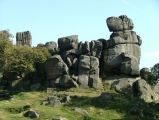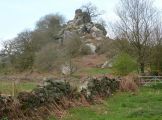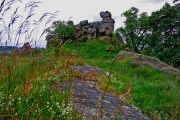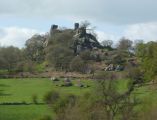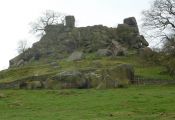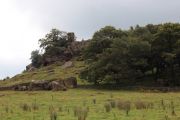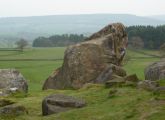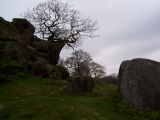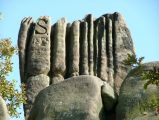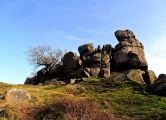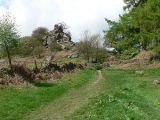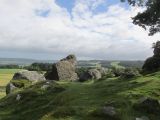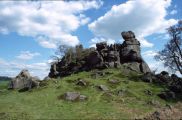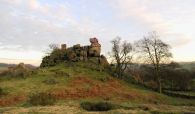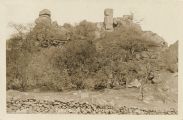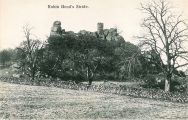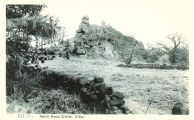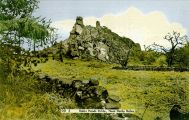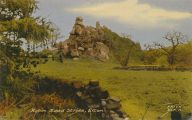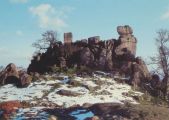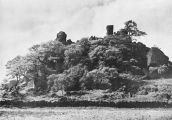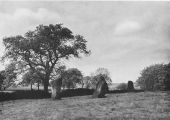Robin Hood's Stride (Harthill): Difference between revisions
mNo edit summary |
mNo edit summary |
||
| Line 6: | Line 6: | ||
Robin Hood's Stride is the name of a formation of broken gritstone rocks on Hartle Moor close to the village of Elton. There is a pinnacle at either end of the formation, that to the west being known as the Weasel pinnacle and that to the east as the Inaccessible pinnacle.<ref>[http://en.wikipedia.org/wiki/Robin_Hood's_Stride Wikipedia: Robin Hood's Stride.]</ref> The formation is said to owe its name to the belief that the distance between the two pinnacles was equal to the length of Robin Hood's step or stride.<ref>{{:Dobson, Richard Barrie 1976a}}, p. 297.</ref> The alternative name of Mock Beggar's Hall is probably due to the general resemblance of the entire formation to a hall (manor house) with each pinnacle as a "chimney" at either end of the "building". The name Robin Hood's Stride is first recorded in an 1819 enclosure award.<ref>{{:Cameron, Kenneth 1959a}}, vol. I, p. 109.</ref> As Kenneth Cameron notes in one of the English Place-Name Society volumes on Derbyshire, this and all other Robin Hood-related place-names in Derbyshire are first recorded at a late date.<ref>{{:Cameron, Kenneth 1959a}}, pt. III (vol. XXIX), p. 760.</ref> | Robin Hood's Stride is the name of a formation of broken gritstone rocks on Hartle Moor close to the village of Elton. There is a pinnacle at either end of the formation, that to the west being known as the Weasel pinnacle and that to the east as the Inaccessible pinnacle.<ref>[http://en.wikipedia.org/wiki/Robin_Hood's_Stride Wikipedia: Robin Hood's Stride.]</ref> The formation is said to owe its name to the belief that the distance between the two pinnacles was equal to the length of Robin Hood's step or stride.<ref>{{:Dobson, Richard Barrie 1976a}}, p. 297.</ref> The alternative name of Mock Beggar's Hall is probably due to the general resemblance of the entire formation to a hall (manor house) with each pinnacle as a "chimney" at either end of the "building". The name Robin Hood's Stride is first recorded in an 1819 enclosure award.<ref>{{:Cameron, Kenneth 1959a}}, vol. I, p. 109.</ref> As Kenneth Cameron notes in one of the English Place-Name Society volumes on Derbyshire, this and all other Robin Hood-related place-names in Derbyshire are first recorded at a late date.<ref>{{:Cameron, Kenneth 1959a}}, pt. III (vol. XXIX), p. 760.</ref> | ||
Robin Hood's Stride is a popular tourist attraction. | Robin Hood's Stride is a popular tourist attraction and no doubt has been visited by more climbers than outlaws. | ||
<!--{{#ask:[[Category:Allusions (Robin Hood's Stride in Harthill)]]|format=embedded|embedformat=h4|columns=1|limit=1000|sort=Utitle}}--> | <!--{{#ask:[[Category:Allusions (Robin Hood's Stride in Harthill)]]|format=embedded|embedformat=h4|columns=1|limit=1000|sort=Utitle}}--> | ||
Revision as of 07:53, 1 January 2018
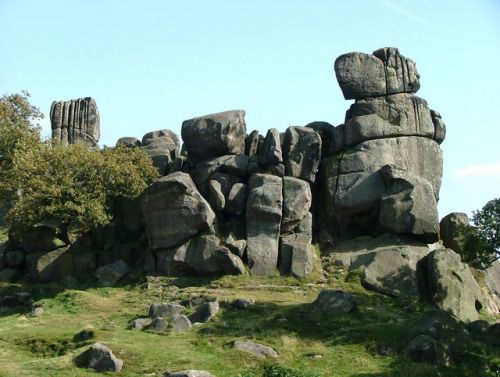
By Henrik Thiil Nielsen, 2014-10-14. Revised by Henrik Thiil Nielsen, 2018-01-01.
Robin Hood's Stride is the name of a formation of broken gritstone rocks on Hartle Moor close to the village of Elton. There is a pinnacle at either end of the formation, that to the west being known as the Weasel pinnacle and that to the east as the Inaccessible pinnacle.[1] The formation is said to owe its name to the belief that the distance between the two pinnacles was equal to the length of Robin Hood's step or stride.[2] The alternative name of Mock Beggar's Hall is probably due to the general resemblance of the entire formation to a hall (manor house) with each pinnacle as a "chimney" at either end of the "building". The name Robin Hood's Stride is first recorded in an 1819 enclosure award.[3] As Kenneth Cameron notes in one of the English Place-Name Society volumes on Derbyshire, this and all other Robin Hood-related place-names in Derbyshire are first recorded at a late date.[4]
Robin Hood's Stride is a popular tourist attraction and no doubt has been visited by more climbers than outlaws.
Gazetteers
Sources
- Cameron, Kenneth. The Place-Names of Derbyshire (English Place-Name Society, vols. XXVII-XXIX) (Cambridge, 1959), vol. I, p. 109; pt. III, p. 760.
- Wikipedia: Robin Hood's Stride.
Maps
- 6" O.S. map Derbyshire XXVIII.SE (1884; surveyed 1877-78)
- 1" O.S. map Sheet 111 (Hills) (1897)
- 1" O.S. map Sheet 111 (Outline) (1897)
- 6" O.S. map Derbyshire XXVIII.SE (1900; rev. 1897)
- 6" O.S. map Derbyshire XXVIII (1923; rev. 1919-20)
- 6" O.S. map Derbyshire XXVIII.SE (1923; rev. 1919-20).
Discussion
- Ackerley, Fred G. 'Robin Hood's Stride', Notes & Queries, Series 10, vol. II (1904), p. 246; suggests the hill was used as a fort in prehistoric times, possibly connected with the nearby "Castle Ring" site.
Brief mention
Notes
- ↑ Wikipedia: Robin Hood's Stride.
- ↑ Dobson, R. B., ed.; Taylor, J., ed. Rymes of Robyn Hood: an Introduction to the English Outlaw (London, 1976), p. 297.
- ↑ Cameron, Kenneth. The Place-Names of Derbyshire (English Place-Name Society, vols. XXVII-XXIX) (Cambridge, 1959), vol. I, p. 109.
- ↑ Cameron, Kenneth. The Place-Names of Derbyshire (English Place-Name Society, vols. XXVII-XXIX) (Cambridge, 1959), pt. III (vol. XXIX), p. 760.
Robin Hood's Stride / J147, 11 Sep. 2007, Creative Commons, via Geograph.
Robin Hood's Stride from the southeast / Andrew Hill, 11 Apr. 2011, Creative Commons, via Geograph.
Robin Hood's Stride from the north / Tom Heyes, on or before 10 Jun. 2009, Attribution-No Derivative Works, via Panoramio.
Robin Hood's Stride / Andrew Hill, 12 Apr. 2011, Creative Commons, via Geograph.
Robin Hood's Stride. 'Seen from the footpath approaching from the lane near Harthill Moor Farm' / Andrew Hill, 11 Apr. 2011, Creative Commons, via Geograph.
Robin Hood's Stride. western end of main formation / Andrew Hill, 11 Apr. 2011, Creative Commons, via Geograph.
Robin Hood's Stride / Graham Hogg, 20 jul. 2014, Creative Commons, via Geograph.
Outlying rocks at Robin Hood's Stride / Andrew Hill, 11 Apr. 2011, Creative Commons, via Geograph.
View of Robin Hood's Stride / Neil Theasby, 18 Jul. 2013, Creative Commons, via Geograph.
Rock outcrop at Robin Hood's Stride / Martin Speck, 3 May 2012, Creative Commons, via Geograph.
Robin Hood's Stride / J147, 11 Sep. 2007, Creative Commons, via Geograph.
Robin Hood's Stride / Brian Frost, 13 Mar. 2014, Creative Commons, via Geograph.
Robin Hood's Stride, from the footpath leading to it / Sam Styles, 2 May 2005, Creative Commons, via Geograph.
Rocks at Robin Hood's stride / Steven Ruffles, 8 Aug. 2016, Creative Commons, via Geograph.
Robin Hood's Stride / Darius Khan, 10 Jun. 2003, Creative Commons, via Geograph.
Robin Hood’s Stride at Sunset / Andrew Huggett, 21 Jan. 2006, Creative Commons, via Geograph.
Marshall, A. Robin Hood's Stride (Winster, [s.d.]). Photographic postcard (b./w.) / Private collection.

